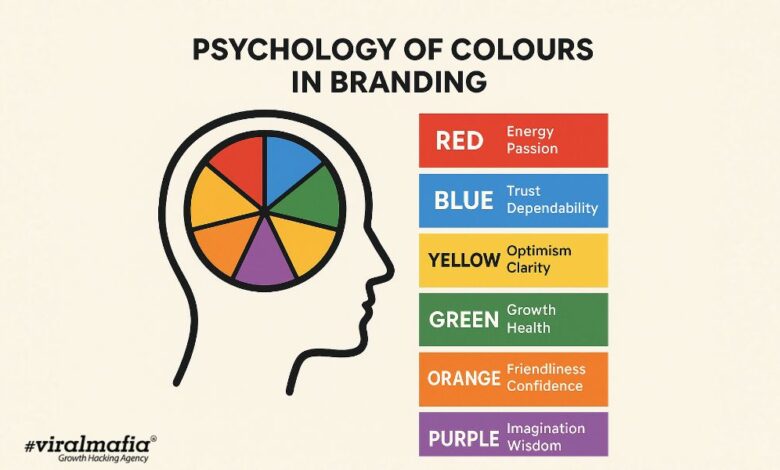The Psychology of Colours in Branding: How Colour Influences Customer Perception

“Colours, like features, follow the changes in emotions” is a famous quote by Pablo Picasso. Colour has the power to influence the soul directly, it is the way nature smiles. Each colour carries a particular emotion; some are smooth and uplifting, evoking hope, while others feel oppressive and authoritative.
As socially engaged individuals, we encounter countless brands in our lives. Red screams urgency. Blue whispers trust. Yellow delivers hope. Some brands instantly feel click-worthy. Colour psychology plays a huge role in branding—sometimes, a poor colour choice can undermine the entire business perspective, while the right colour grading can elevate even a simple thread to top-tier status.
Viral Mafia reveals the best colours to stop scrolls, weaponized spike sales, and stamp your brand into the minds of followers. Are you ready to paint your way to profit? As a foremost digital marketing agency in Kerala, Viral Mafia will guide you through every step of marketing your product or service, transforming it into a powerful a brand.
Why is Colour Important in Branding?
Colour is one of the most powerful tools in branding—it shapes how customers perceive, remember, and feel about a brand. A perfect colour choice creates a seamless strike in the minds of the audience. In fact, most studies show that colour plays a bigger role in brand recognition than many people realize. It instantly makes a brand identifiable, even without its name.
The truth is, colour goes beyond visibility. It triggers emotional responses, influences trust, and even drives purchasing decisions. Several factors make colour a critical element in branding, including the following:
Emotional Connection: Each color’s vibrancy depends on the product, service, brand identity, and target audience—all of which shape customer emotions. For example:
Red sparks excitement, energy, love, and strength
Orange radiates warmth, optimism, and sociability
Yellow exudes happiness, joy, and creativity
Green evokes harmony, balance, freshness, and safety.
Trust and Perception: The choice of colour can make a brand feel credible and authentic. Imagine a law firm in bright pink versus deep navy, it would seem hilarious and less professional. A lawsuit, in our minds, always appears in black and white. Certain associations work this way when we consider audience perception.
We live in an era where stereotypes are being broken, and brands can experiment with new trials and errors. However, these experiments should be strategic, helping the brand expand its reach and connect with a wider audience.
Subtle Decision Making: Some shoppers choose colour as their sole weapon against branding. A single colour alone can become a silent yet powerful sales tool. In the past, colour was seen merely as decoration, a finishing touch. But in reality, it’s a crucial decision that impacts perception, loyalty, and success.
What is the Psychology Behind the Popular Brand Colours?
Brands use color psychology as a powerful technique to choose distinctive colors that help them stand out from competitors. Some shades become iconic, instantly recognizable and unforgettable. Companies strategically leverage colors to make their products more appealing, because visuals are the first sense that hooks any individual.
Red
The colour red always passion, urgency, appetite, excitement, energy, love, strength. Red is a bold color that is very hard to ignore. In business perspective sales, offers discounts are always written in big block red letters. Youth-oriented brands tend to make it crave, especially food brands.
Example: Coca-Cola, Netflix, McDonald’s use red shade, which makes them distinctive and identifiable from far away. They have received a lot of advantages.
Blue
Blue is widely considered the most trusted color, making it the go-to choice for finance and healthcare industries. It’s ideal for brands that want to project dependability and professionalism.
Example: Facebook, Samsung, and American Express uses blue and these brands very much call out for reliability, while American Express leverages it for financial trust. Blue is a safe colour for corporates and tech-related brands.
Yellow
The color yellow is incredibly uplifting. Just imagining it conjures images of bright sunny days and evokes memories of perfect summer vacations. Yellow effortlessly grabs attention with its radiant energy. As a playful and vibrant hue, it’s one of the most powerful colors for making a bold statement.
Example: McDonald’s pairs yellow with red to create a fast and happy vibe. McDonalds strategically pair the yellow and red — individually the colours may not work as well, but together the combination strikes well. IKEA uses yellow and blue to reflect affordability. Snapchat for playful energy. Yellow is sunshine in branding form.
Green
Green is a known colour depicting nature. It signals eco-friendliness, it is so calming and renewing very suitable for organic or any kind of sustainable and biodegradable products.
Example: Starbucks, Whole Foods, and Spotify are famous for using green colour for their brands. Starbucks links green to natural ingredients, Whole Foods to organic quality, and Spotify to fresh music discovery. It’s the color of renewal and eco-friendliness.
Purple
Historically tied to royalty, purple is a colour for denoting luxury. Most beauty products use purple hues and shades to evoke sophistication and whimsy.
Example: Yahoo Messenger uses purple to depict the creative and imaginary side. Cadbury and Milka use purple for premium chocolate indulgence.
Black
Black shows sleek, timeliness, authority, and elegance. Since it is an authoritative colour, most brands use it as power, mostly automobiles, and also modern technical brands initiating authoritative leveraging minimalism.
Example: Nike, Chanel, Apple are the common brands that use black colour for brands ultimate high-class statement.
White
White is a serene colour that spreads purity, space, and healthcare, and it also equally showcases minimalism. It evokes transparency and precision.
Example: Apple’s white in the background is a cutting-edge minimalism, Adidas uses it for crisp athleticism, and Tesla for futuristic purity. White is the blank canvas of premium branding. It can be any brand, using white colour as a background in letters, designs, or patterns — white can feel very affirmative and supreme.
Colors create distinct emotional experiences. Beyond their varied shades and hues, they’re deliberately chosen by brands to evoke specific feelings in consumers, directly influencing perception. Here’s why these color choices are essential across industries.
How do You Choose the Right Colour for Your Brand?
Picking your brand colours is not just about what you like; it is about what your customers connect with. The factors for choosing colour for your brand.
Determination: Determine what kind of products or services you are focusing. What suits you the best, bold or calm or premium? What are you looking for?
Audience: Some brands target specific audiences through color psychology. Younger consumers prefer vibrant colors, while premium buyers gravitate toward sleek neutrals.
Comparison: Observe your direct competitors, don’t blend in with the crowd. Choose wisely and strategically what will work for you.
Test: Try different color palettes to see what resonates with people. Today, social media and internet make it easy to gather reviews and feedback. Discover what truly clicks with your audience.
How Does Viral Mafia Help You Create Powerful Branding?
Viral Mafia focuses on creating brand colors that not only look good but also align with business goals enhancing, SEO, SEM, SMM, and performance as a leading Google Ads Agency in Kerala.
As the best digital marketing agency in Calicut, we approach marketing differently by integrating psychology with data-driven strategy, design expertise, and real-world testing to develop colors that stimulate emotions and ensure effective marketing campaigns.






